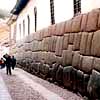 Text search Text search
 Related images Related images
 HistoryWorld HistoryWorld
 Link Link
 Map Map
Click the icons to visit linked content. Hover to see the search terms. |
|  |
| | | | | | | |
|
| c. 3000 BC |
| | | Complex societies, with sophisticated temple architecture, develop at sites such as Aspero and Caral in the Norte Chico region of Peru | |
| |
|
| c. 1000 BC |
| | | The Olmecs raise large clay platforms, probably with temples at the top, beginning the long American tradition of sacred pyramids | |   
| |
|
| c. 1000 BC |
| | | Burial mounds feature in the Ohio valley, built first in the Adena culture and then by Hopewell tribes | |   
| |
|
| c. 200 BC |
| | | The earth drawings of the Nazca people, known now as the Nazca Lines, are some of the largest works of art ever created | |  
| |
|
| c. 1450 |
| | | The massive architecture of the Incas, consisting of finely dressed irregular blocks of stone, becomes a feature of Cuzco | |   
|  | Masonry in Cuzco
Photograph Josceline Dimbleby
|
|
|
| c. 1500 |
| | | Even the remote city of Machu Picchu, on its peak above the jungle, is built in the massively precise Inca style of masonry | | 
|  | Machu Picchu
Photograph Josceline Dimbleby
|
|
|
| 1770 |
| | | 27-year-old Thomas Jefferson begins constructing a mansion on a hilltop in Charlottesville, calling it Monticello ('little mountain') | |   
| |
|
| 1800 |
| | | US president John Adams moves into the newly completed White House, named for its light grey limestone | |   
| |
|
| 1881 |
| | | The Chicago architects Dankmar Adler and Louis Sullivan set up a partnership | |   
| |
|
| 1901 |
| | | Frank Lloyd Wright designs low residential buildings, suitable for the plains around Chicago, and calls them Prairie Houses | |   
| |
|
| | | | | |
| |